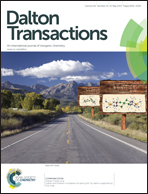Temperature-dependent studies of [(CH3)2NH2][FeIIIMII(HCOO)6] frameworks (MII = Fe and Mg): structural, magnetic, dielectric and phonon properties†
Abstract
Novel heterometallic formate [(CH3)2NH2][FeIIIMgII(HCOO)6] (DMFeMg) was prepared and characterized by single crystal X-ray diffraction, DSC, dielectric, magnetic susceptibility, Raman and IR methods. We also report thermal, Raman and IR studies of the known compound [(CH3)2NH2][FeIIIFeII(HCOO)6] (DMFeFe). DMFeMg crystallizes in the niccolite structure (P![[3 with combining macron]](https://www.rsc.org/images/entities/char_0033_0304.gif) 1c space group). In contrast to the known DMFeFe, [(CH3)2NH2][FeIIIMnII(HCOO)6] (DMFeMn) and [(CH3)2NH2][FeIIICoII(HCOO)6] (DMFeCo) formates, the metal ions in DMFeMg are distributed statistically over the two available octahedral sites. Temperature-dependent studies show that whereas DMFeFe exhibits an order–disorder phase transition at 151.8 K upon cooling, freezing-in of re-orientational motions of DMA+ cations does not lead to any structural phase transition in DMFeMg. We discuss the origin of this difference. The low-temperature studies also show that DMFeMg orders magnetically at TC = 13.5(5) K and the shape of M(T) measured in the field-cooling regime suggests ferromagnetic character of the ordering.
1c space group). In contrast to the known DMFeFe, [(CH3)2NH2][FeIIIMnII(HCOO)6] (DMFeMn) and [(CH3)2NH2][FeIIICoII(HCOO)6] (DMFeCo) formates, the metal ions in DMFeMg are distributed statistically over the two available octahedral sites. Temperature-dependent studies show that whereas DMFeFe exhibits an order–disorder phase transition at 151.8 K upon cooling, freezing-in of re-orientational motions of DMA+ cations does not lead to any structural phase transition in DMFeMg. We discuss the origin of this difference. The low-temperature studies also show that DMFeMg orders magnetically at TC = 13.5(5) K and the shape of M(T) measured in the field-cooling regime suggests ferromagnetic character of the ordering.
![Graphical abstract: Temperature-dependent studies of [(CH3)2NH2][FeIIIMII(HCOO)6] frameworks (MII = Fe and Mg): structural, magnetic, dielectric and phonon properties](/en/Image/Get?imageInfo.ImageType=GA&imageInfo.ImageIdentifier.ManuscriptID=C5DT00512D&imageInfo.ImageIdentifier.Year=2015)

 Please wait while we load your content...
Please wait while we load your content...